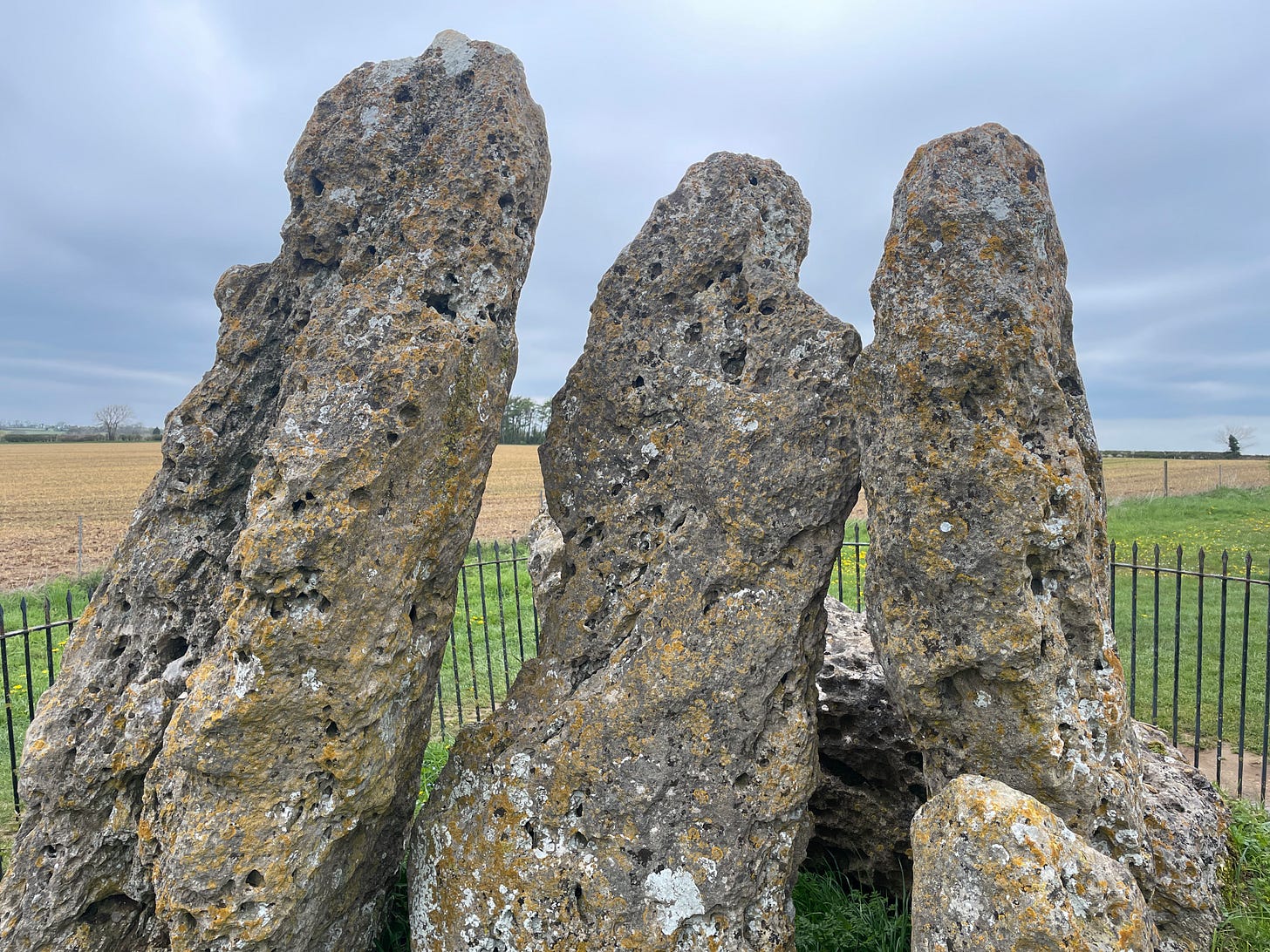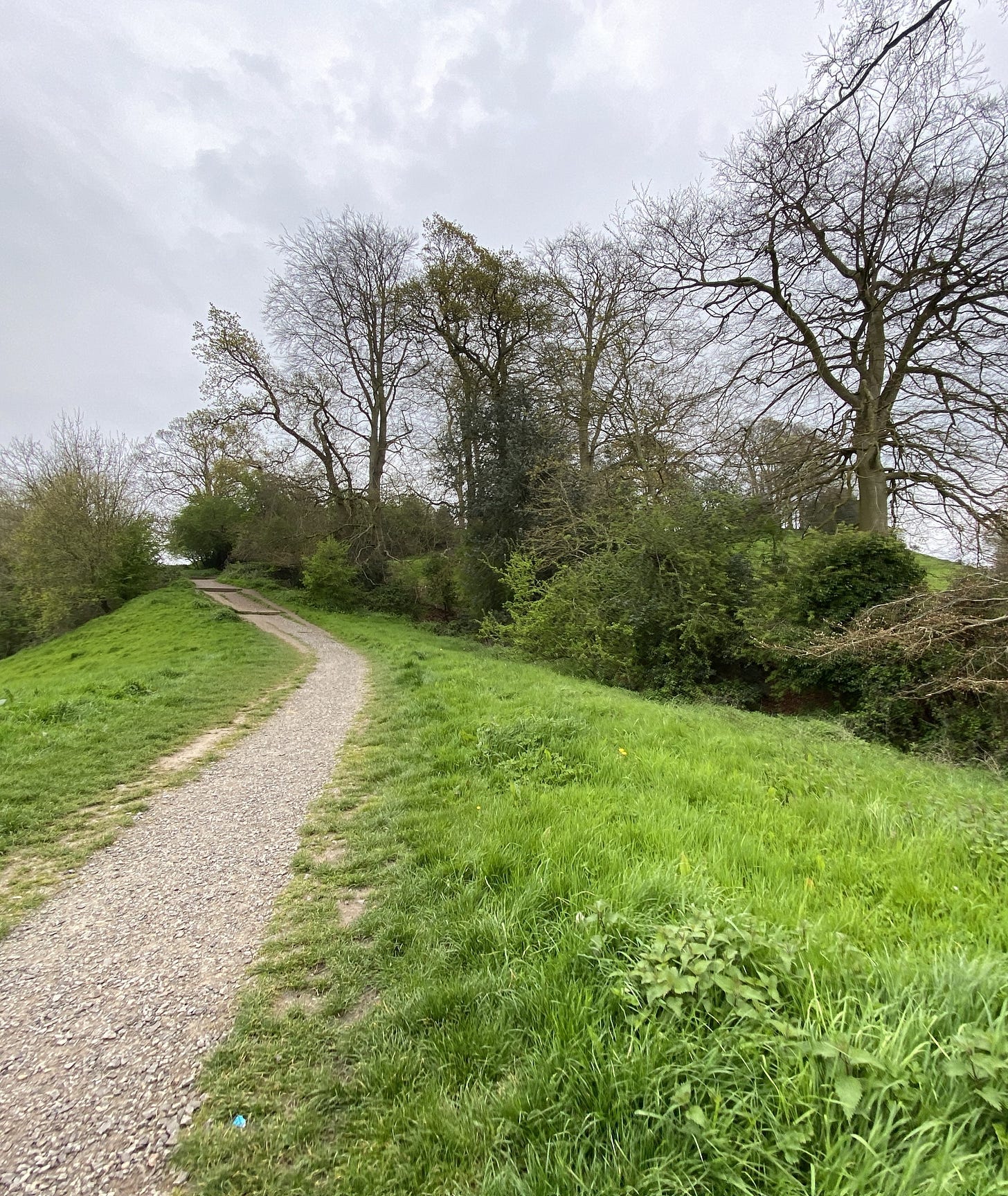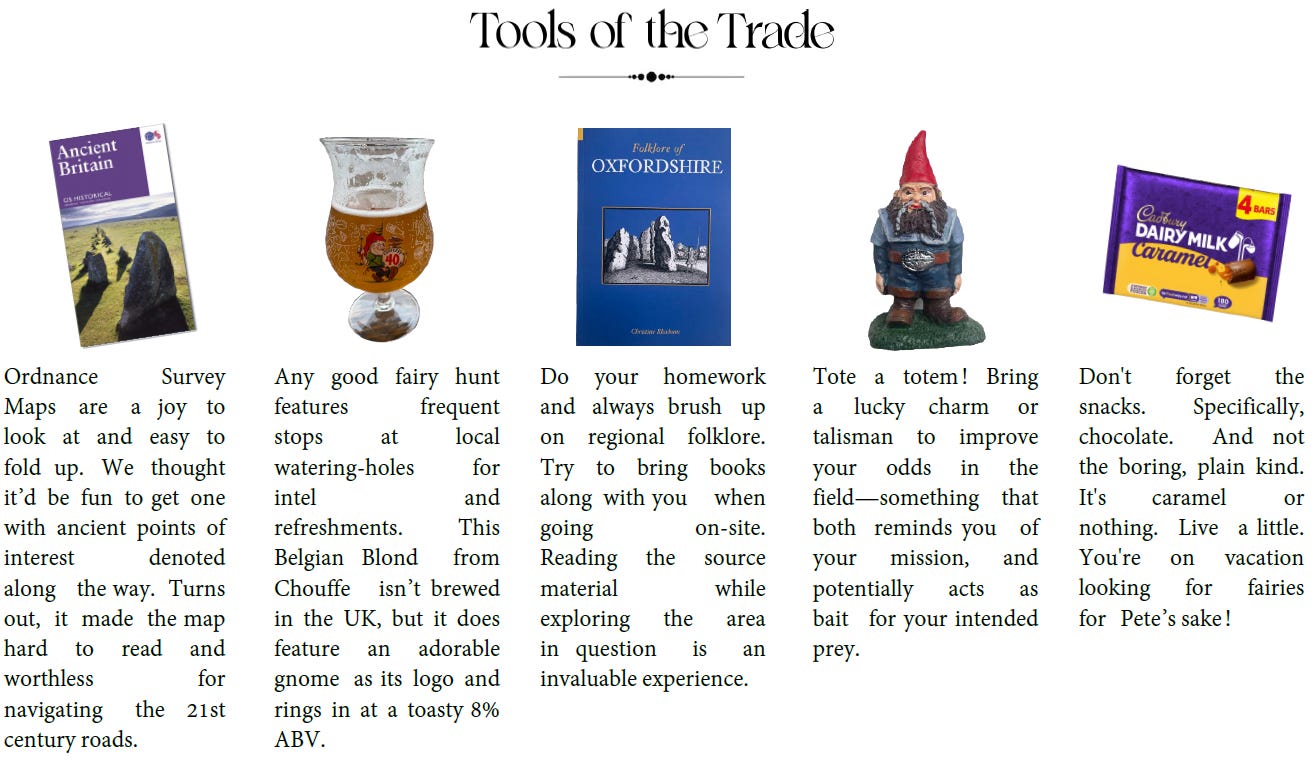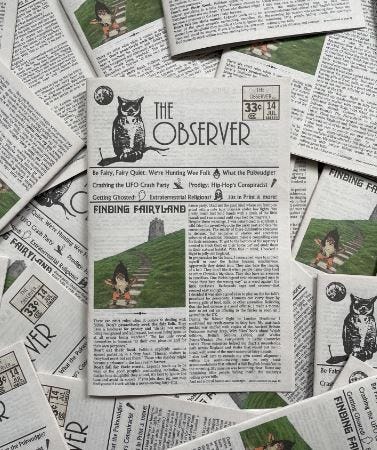Read Part 1, Part 2, Part 3
Rollright Stones
After weighing down my rented 4-banger with an irresponsible number of books purchased in Hay on Wye, I headed due east. My destination was a group of megaliths on the border of Warwickshire and Oxfordshire known as the Rollright Stones. The site’s impressive ceremonial stone circle—the King’s Men—was constructed around 2,500 BC. The nearby burial chamber known as the Whispering Knights predates it by about 1,000 years. Across the road (which happens to be an ancient British trackway) stands the latest addition—the solitary King Stone.

Continuing the tradition that links standing stones with the little people, Rollright is often held to be the last known location of England’s fairies. Legends claim that they occupied the stones only after the Druids who erected them disappeared. The supernatural squatters reputedly bring misfortune to those who mess with the monoliths.
In The Rollright Stones and Their Folk-lore, Arthur J. Evans documented regional figures who claimed that “the fairies dance round the King-stone.” He related a story told to him by a woman who witnessed fairies coming and going through a hole under the King Stone. She remembered a time as a child when she placed a rock over the tiny entrance to block the the wee folks’ passage, but the obstruction was always removed by morning.
Another individual told Evans that “people who led a pure life could see fairies near the Whispering Knights.” If true, it would explain why my visit produced such poor results.
My inspection was initially delayed by a man sitting in the middle of the King’s Men circle with a bucket of crystals waving the Union Jack. His ritual continued for a solid 5-minutes before I asked him what he was doing. He told me he lived nearby, but the Rollright Stones were his true “home.” When I redirected the conversation to ask if he’d seen any fairies within his domain, he declined to answer and removed himself from the circle.
Somehow I had weirded-out the weird guy. Great start.

A thorough examination revealed no secret doorways or hollow stones, but I reminded myself to stay positive since most of the local fairy legends revolved around the King Stone.
Those hopes were soon dashed when I saw a flimsy orange fence around a large area of the monument. The stone was under repair and off-limits to visitors. It seemed a little too convenient. I couldn’t help wondering if something was deliberately hindering my progress.
On the walk back to the car, I weighed my options. My time Across the Pond was running short and I needed a ‘fairy Hail Mary’ to score big on my last play. With the help of the Ordnance Survey map I identified the perfect place to make my final stand: the magical town of Glastonbury.
Glastonbury Tor
The route from Rollright to Glastonbury cuts through some of the prettiest country in England. Rolling green pastures, storybook villages, and stone-built homes that have stood the test of centuries—at least that’s what I’m told is on the other side of the vision-impairing hedges lining the thin strips of pavement that pass for “roads” in the Cotswolds.
After a white-knuckle 2-hour drive on a lane designed for golf carts, I found a parking spot on a busy Glastonbury side street. It was well before noon and the city was just waking up. As the ever-present precipitation began dotting my windshield, I stepped outside to grab a coffee and comb the city for fairies.
Glastonbury is celebrated for its relaxed vibe and appreciation for the occult. Its most distinctive landmark is the magnificent 518-foot-tall Tor and the accompanying tower of St. Michael. The grand hill gives off an otherworldly feel, jutting unnaturally from the flat land it overlooks. The sacred site has been religiously significant for more than 1,000 years. It was also once purported to be the home of the King of the Fairies.
Forget what I said earlier about Silbury Hill being primo real estate for the good folk. That was before I’d laid eyes on the Glastonbury Tor. If I was a fairy looking for a mound to call home, the Tor would check every box. It’s hardly surprising that legends claim it contained an entrance to the fairy realm—a portal through which the Fairy King “Gwyn ap Nudd” led legions of supernatural beings on “fairy rades” across the countryside.
The trek up the Tor was every bit as arduous as it looked from the bottom. On my way up, I spent a fair amount of time scanning the hillside for small openings that might indicate an entrance. The vibrant greenery and ancient winding pathways felt like first-class fairy country. Alas, I saw neither hide nor hair of the elusive creatures.
Perhaps the fairies had vacated the region. Centuries ago, the Celtic Saint Collen parlayed with Gwyn ap Nudd in his invisible palace atop the Tor. Before the powerful fairy could pull any tricks, St. Collen rebuked the enchantment with a splash of holy water, dissolving the illusory kingdom. This act probably drove the fairies to seek refuge somewhere else. Whatever the case, I didn’t chance upon any during my time at the Tor, but I did capture stunning views of Somerset and experienced why generations of people have been attracted to this unusual English hilltop.
On my way back from the Tor, I walked by a few residences with fairy doors installed on the foot of their buildings. The miniature entryways felt like an olive branch from Glastonbury’s concerned citizens—a way to distance themselves from St. Collen’s actions and invite the kind neighbors back within the city’s boundaries.
There and Back Again...
“See what thieves these fairies are!”
After a week of driving on the wrong side of the road, and eating more meat for breakfast than I normally do at dinner, I never got close to seeing a fairy. I suspect they keep odd twilight hours—something hard to do when you spend all day traveling. Maybe I don’t possess what the fairy-faith followers call “second sight.” These psychically inclined individuals have an innate ability to see a supernatural world that others can’t.
However, there was a modicum of evidence that the little people were afoot during my visit.
A common fairy trait is a penchant for pilfering goods. Whether stealing food from vendors at the market or nabbing human babies from their mothers, the wee folk have a bad habit of taking things that aren’t theirs.
To that point, I can’t tell you how many times my cell phone went missing only to end up somewhere I’d previously searched. The little swindlers would hide it when I wasn’t looking, then laugh from the shadows while I tore the car apart looking for the darn thing. As soon as I’d go digging under the seat, they’d place the phone in the center console where I was positive I’d already checked.
I’m also pretty sure they took €20 from me. They made it disappear from my pants pocket…or maybe my backpack…I don’t remember specifically where I left it, but I’m sure it was there one minute, and inexplicably gone the next.
I know what you’re thinking—that I probably just misplaced these items without realizing it. To you I say this: Stop taking sides with my girlfriend.

Beyond these subtle encounters, my hunt was a failure; but that doesn’t mean my trip was a waste. My adventures in England and Wales afforded me a lifetime of memories and opened my eyes to the hauntingly romantic lands of the United Kingdom. The country’s history and hospitality combined to deliver an unrivaled experience. I’m already staking out fairy mounds further south to see if Cornish elves are less timid than their cousins to the north.
Did I encounter any fairies? No. But even if I did, I wouldn’t tell. Everyone knows that their magic disappears as soon as it’s revealed to others.















That is quite the adventure you had!